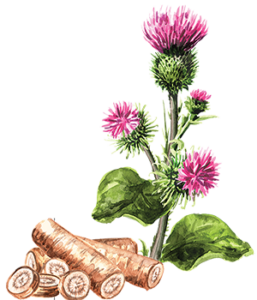 Chinese name: Niu bang zi
Chinese name: Niu bang zi
Latin name: Arctium lappa (Asteraceae)
Appearance: A bienniel that produces a rosette of large leaves in its first year, then stems that grow up to 5 feet with reddish-purple flower heads and hooked bracts.
Habitat: Native to Europe and Asia, but now grows in temperate regions throughout the world.
Properties: Detoxifying, mild diuretic, antibiotic, antiseptic, anti-inflammatory, antifungal, hypoglycemic, antitumor, hepatoprotective
Parts used: Roots dug during first growing season; leaves and fruit (containing seeds) harvested in late summer/early fall
Primary preparations: Leaves, seeds, fruit, roots can be used fresh or dried; may be prepared as decoctions, tinctures, infusions, or poultices
Practical uses: Skin conditions such as psoriasis, eczema, oily skin, acne, boils; gout; arthritis; staph infection
Combinations: Burdock is rarely used on its own in remedies. It is often combined with dandelion, yellow dock, or red clover.
Editor’s note: Consult with a qualified healthcare professional before attempting to self-treat ailments.
SOURCE: Chevallier A. Encyclopedia of Herbal Medicine. New York, NY: DK Publishing; 2016:56.





